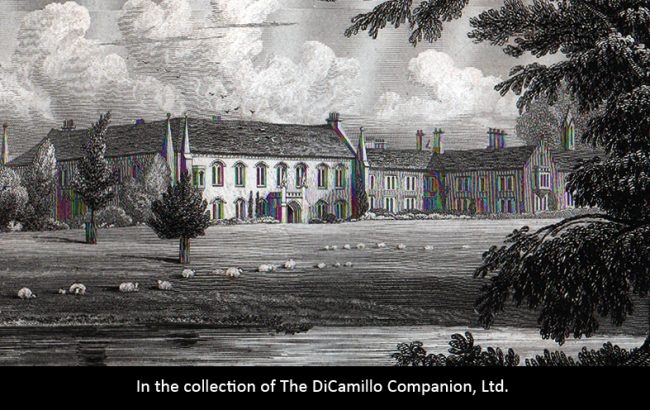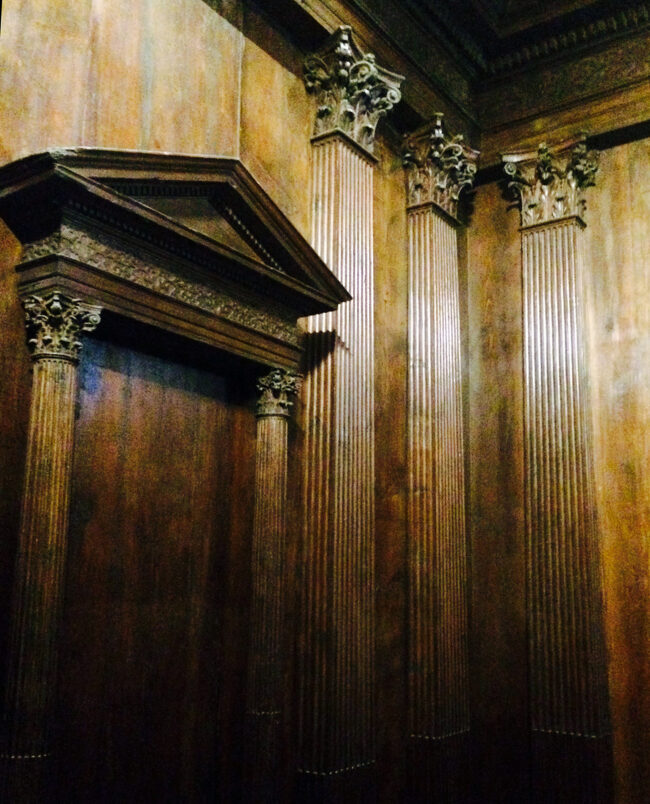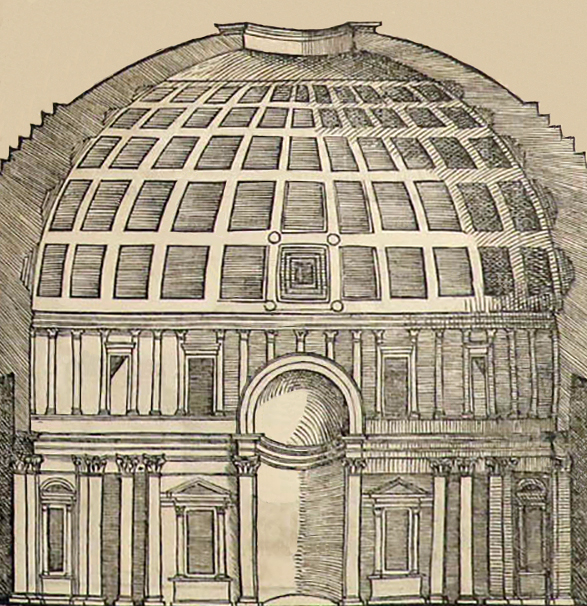
An 1829 engraving of the house from "Neale's Views of Seats"

The Haynes Grange paneling, originally installed at Chicksands, as seen today at the V&A.

Drawing of the interior of the Roman Pantheon from Serlio's 16th century "Seven Books on Architecture." The Haynes Grange paneling, originally installed at Chicksands, was very likely modeled on this drawing.
House & Family History: The Priory of Chicksands was founded circa 1152 by Rohese, Countess of Essex, and her second husband, Payn de Beauchamp, Baron of Bedford. The priory was part of the Gilbertine Order, a religious order formed by Gilbert of Sempringham (1083-1189), and only one of ten religious houses in England that housed both nuns and canons. Fleeing the soldiers of King Henry II after the Council of Northampton in 1164, Archbishop Thomas Becket is said to have spent time at Chicksands on his journey out of England. Chicksands Priory was officially dissolved on October 22, 1538 by Henry VIII as part of the Dissolution of the Monasteries. As there were no Gilbertine houses on the continent, the order ceased to exist after its houses were closed in England. After its conversion to a private house, Chicksands was the seat of the Osborn family for 400 years. The famous letter-writer Dorothy Osborne lived here between her birth in 1627 and her marriage in 1654. The Crown Commissioners bought Chicksands on April 15, 1936; they leased it as a private home until it was requisitioned by the Royal Navy in 1940, after which it became RAF Chicksands Priory. In 1950 the United States Air Force took over; they continued to use the house as a listening post until 1995. In 2001 the Channel 4 TV program "Time Team" excavated sections of the original priory, uncovering part of what was believed to be the infirmary cloister and several graves.
Collections: The Haynes Grange paneling (see "Images" section), which may have been designed by Inigo Jones, is part of one of the earliest interiors in Britain planned according to the principles of classical architecture. The design of the paneling, noted for its Corinthian pilasters, was almost certainly inspired by an engraving of the interior of the Pantheon in Rome that appeared in Sebastiano Serlio’s immensely influential “Seven Books on Architecture”(see “Images” section), published in Italy between 1537 and 1551. The pine paneling, which was probably created between 1590 and 1620, is unusual for its unpainted surfaces (pine paneling during this time was usually painted in bright colors). In spite of its name, it is now believed that the room, also known as the Pigeon Gallery (from the birds on its ceiling), was originally installed at Chicksands as a gallery. Around 1754 the paneling was moved to Haynes Grange (hence its name), where it was probably reduced to fit a smaller space. Circa 1909 the paneling was sold from Haynes Grange and reinstalled at 13 Lansdowne Road, Holland Park, London. The paneling was purchased from 13 Lansdowne Road in 1929 by the Victoria & Albert Museum, in whose collection it remains today. Previously the paneling was thought to have come from Houghton House in Bedfordshire, but this theory was disproved by Mark Girouard in 1992.
Architect: Isaac Ware
Date: Circa 1735-40Architect: James Wyatt
Date: 1815John Bernard (J.B.) Burke, published under the title of A Visitation of the Seats and Arms of the Noblemen and Gentlemen of Great Britain and Ireland, among other titles: 2.S. Vol. I, p. 187, 1854.
John Preston (J.P.) Neale, published under the title of Views of the Seats of Noblemen and Gentlemen in England, Wales, Scotland, and Ireland, among other titles: 2.S. Vol. V, 1829.
House Listed: Grade I
Park Listed: Grade II
Past Seat / Home of: Richard and Elizabeth Snowe, 1539-87. Peter Osborne, until 1592; Sir John Osborne, 17th century; Sir Danvers Osborn, 18th century; Sir Algernon Osborn, early 20th century; Osborn(e) family here from 1587 until 1936. Gerald Bagshawe, 1936-40.
Current Ownership Type: The Crown / Royal Family
Primary Current Ownership Use: Mixed Use
Ownership Details: Owned by the Crown Commissioners since 1936.
House Open to Public: Yes
Historic Houses Member: No